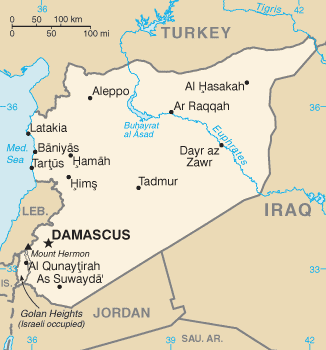This morning, as my mother was having her conference in the hotel, I was not alone or staying in the room. Gladly the wife of my mother’s friend (kak Amnah) came by and accompanied me to go to the National Museum of Syria. It was only about 10 minutes walk from our hotel.



The National Museum of Syria when I went to was still under reconstruction at some parts of the building, which is under collaboration with the Italian government. However, the numbers of Rome monuments, scriptures and remnants of the country was more emphasized in the museum, as if mitigating the Islamic influence of the country. This is my perspective as from what I saw and we even got a chance to have a look into a room that was filled with pictures on the wall, describing a story of Prophet Musa a.s. as being told in the Qur’an, Taurat and Injil.


We then had our lunch with my mom and her other friends at an Arab restaurant. It was actually an awkward for the Arabs to have women eating huge meals inthe restaurants with the men, coz they usually eat separately between male and female. The meal was sooo huge, which I thought we might never able to finish it. But we finished it, maybe because we were all hungry and we took smaller meal (3 people eating a meal for 2).


We spent the evening then by continuing our shopping activities at Souq Hamidi (again) and Souq Towiil. Thanks to Mukaramah and Asma’ (the Malaysian students who are studying there) for helping us in buying things, even brought us to the underground area to buy cheap robes and abayas. I’ve learnt some of the key words in buying things there example ‘addish (how much?) and takhfif syuwaih (can you lower the price). These communication words could not be found in my previous Arabic language textbook…
There's one type of dress that almost all the Syrian women are wearing, which I admire of: Monteaus. They are basically chic coats, like those are worn by Western women as over a suit or a dress. But they are ankle length and wear with hijab being tucked in. So it’s not loose or flowy but more fitted and smart. I like them very much but don't think it will be appropriate to wear in Malaysia because of the hot weather.
 The cost of living in Damascus is still cheap as compared to Malaysia or Singapore. This may be due to the existence of many souq compare to the supermarkets, where the prices of the goods and things are much more cheaper and also the tenants of each shops. The market sellers are very hardworking people, they even open their shops till late at night, a high spirit lesson I’ve earned from them.
The cost of living in Damascus is still cheap as compared to Malaysia or Singapore. This may be due to the existence of many souq compare to the supermarkets, where the prices of the goods and things are much more cheaper and also the tenants of each shops. The market sellers are very hardworking people, they even open their shops till late at night, a high spirit lesson I’ve earned from them.




























